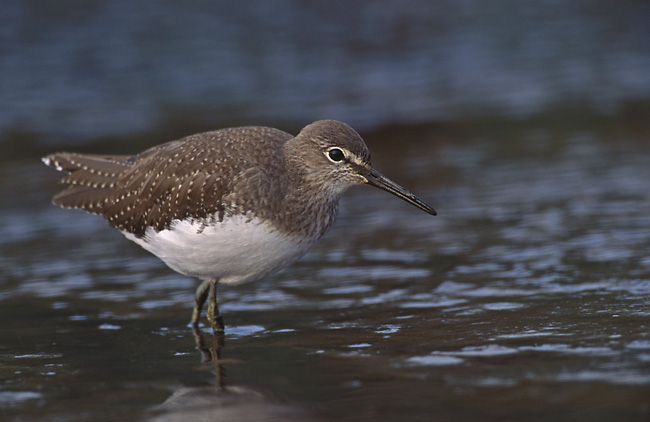Green Sandpiper
From Wikipedia, the free encyclopedia
[Photo] Green Sandpiper (Tringa ochropus). Photo by Marek Szczepanek (http://commons.wikimedia.org/wiki/User:Pkuczynski/Marek_Szczepanek) Copyright (C) Marek Szczepanek
Permission is granted to copy, distribute and/or modify this document under the terms of the GNU Free Documentation License, Version 1.2 or any later version published by the Free Software Foundation; with no Invariant Sections, no Front-Cover Texts, and no Back-Cover Texts. A copy of the license is included in the section entitled "GNU Free Documentation License". |
The Green Sandpiper, Tringa ochropus, is a small wader (shorebird). Its only close relative in the genus Tringa is the Solitary Sandpiper (Pereira & Baker, 2005); they both have brown wings with little light dots, and a delicate but contrasting neck and chest pattern. In addition, both species nest in trees, unlike most other scolopacids.
It breeds across subarctic Europe and Asia. It is a migratory bird, wintering in southern Europe and Asia, and tropical Africa.
This is not a gregarious species, although sometimes small numbers congregate in suitable feeding areas. Green Sandpiper is very much a bird of fresh water, and is often found in sites too restricted for other waders, which tend to like a clear all-round view.
This species is a dumpy wader with a dark green back, greyish head and breast and otherwise white underparts. The back is spotted white to varying extents, being maximal in the breeding adult, and less in winter and young birds. The legs and short bill are both dark green.
It is obvious in flight, with wings dark above and below, and a brilliant white rump. The latter feature distinguishes it from the slightly smaller but otherwise very similar Solitary Sandpiper of North America to which it is closely related.In flight it has a characteristic three-note whistle.
Green Sandpiper lays 2-4 eggs in an old tree nest of another species, such as a Fieldfare. The eggs take about three weeks to hatch.
Food is small invertebrate items picked off the mud as this species works steadily around the edges of its chosen pond.
The Green Sandpiper is one of the species to which the Agreement on the Conservation of African-Eurasian Migratory Waterbirds (AEWA) applies.
Given its basal position in Tringa, it is fairly unsurprising that apparent hybrids between this species and the Common Sandpiper of the sister genus Actitis have been reported.
http://en.wikipedia.org/wiki/Green_Sandpiper
| The text in this page is based on the copyrighted Wikipedia article shown in above URL. It is used under the GNU Free Documentation License. You may redistribute it, verbatim or modified, providing that you comply with the terms of the GFDL. |
|

